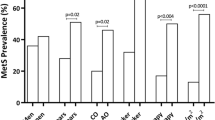Abstract
Purpose
To evaluate the utility of Insulin-like growth factor I (IGF-I) standard deviation score (SDS) as a surrogate marker of severity of hypopituitarism in adults with pituitary pathology.
Methods
We performed a retrospective data analysis, including 269 consecutive patients with pituitary disease attending a tertiary endocrine clinic in 1990–2015. The medical files were reviewed for the complete pituitary hormone profile, including IGF-I, and clinical data. Age-adjusted assay reference ranges of IGF-I were used to calculate IGF-I SDS for each patient. The main outcome measures were positive and negative predictive values of low and high IGF-I SDS, respectively, for the various pituitary hormone deficiencies.
Results
IGF-I SDS correlated negatively with the number of altered pituitary axes (p < 0.001). Gonadotropin was affected in 76.6 % of cases, followed by thyrotropin (58.4 %), corticotropin (49.1 %), and prolactin (22.7 %). Positive and negative predictive values yielded a clear trend for the probability of low/high IGF-I SDS for all affected pituitary axes. Rates of diabetes insipidus correlated with IGF-I SDS values both for the full study population, and specifically for patients with non-functioning pituitary adenomas.
Conclusions
IGF-I SDS can be used to evaluate the somatotroph function, as a valid substitute to absolute IGF-I levels. Moreover, IGF-I SDS predicted the extent of hypopituitarism in adults with pituitary disease, and thus can serve as a marker of hypopituitarism severity.



Similar content being viewed by others
References
Molitch ME, Clemmons DR, Malozowski S, Merriam GR, Vance ML, Shalet SM, Stephens PA (2011) Evaluation and treatment of adult growth hormone deficiency: an Endocrine Society Clinical Practice Guideline. J Clin Endocrinol Metab 96:1587–1609
Hartman ML, Crowe BJ, Biller BMK, Ho KKY, Clemmons DR, Chipman JJ (2002) Which patients do not require a GH stimulation test for the diagnosis of adult GH deficiency? J Clin Endocrinol Metab 87:477–485
Biller BMK, Samuels MH, Zagar A, Cook DM, Arafah BM, Bonert V, Stavrou S, Kleinberg DL, Chipman JJ, Hartman ML (2002) Sensitivity and specificity of six tests for the diagnosis of adult GH deficiency. J Clin Endocrinol Metab 87:2067–2079
Algeciras-Schimnich A, Bruns DE, Boyd JC, Bryant SC, La Fortune KA, Grebe SKG (2013) Failure of current laboratory protocols to detect lot-to-lot reagent differences: findings and possible solutions. Clin Chem 59:1187–1194
Cook DM, Yuen KCJ, Biller BMK, Kemp SF, Vance ML (2009) American Association of Clinical Endocrinologists medical guidelines for clinical practice for growth hormone use in growth hormone-deficient adults and transition patients—2009 update. Endocr Pract 15(Suppl 2):1–29
Ho KKY (2007) Consensus guidelines for the diagnosis and treatment of adults with GH deficiency II: a statement of the GH Research Society in association with the European Society for Pediatric Endocrinology, Lawson Wilkins Society, European Society of Endocrinology. J Eur J Endocrinol 157:695–700
Aimaretti G, Corneli G, Di Somma C, Baldelli R, Gasco V, Rovere S, Migliaretti G, Colao A, Tamburrano G, Lombardi G, Ghigo E, Camanni F (2005) Different degrees of GH deficiency evidenced by GHRH + arginine test and IGF-I levels in adults with pituritary disease. J Endocrinol Invest 28:247–252
Hoeck HC, Vestergaard P, Jakobsen PE, Laurberg P (1995) Test of growth hormone secretion in adults: poor reproducibility of the insulin tolerance test. Eur J Endocrinol 133:305–312
Pfeifer M, Kanc K, Verhovec R, Kocijancic A (2001) Reproducibility of the insulin tolerance test (ITT) for assessment of growth hormone and cortisol secretion in normal and hypopituitary adult men. Clin Endocrinol (Oxf) 54:17–22
Yuen KCJ, Biller BMK, Molitch ME, Cook DM (2009) Is lack of recombinant growth hormone (GH)-releasing hormone in the United States a setback or time to consider glucagon testing for adult GH deficiency? J Clin Endocrinol Metab 94:2702–2707
Yuen KCJ (2011) Glucagon stimulation testing in assessing for adult growth hormone deficiency: current status and future perspectives. ISRN Endocrinol 2011:608056
Kargi AY, Merriam GR (2012) Testing for growth hormone deficiency in adults: doing without growth hormone-releasing hormone. Curr Opin Endocrinol Diabetes Obes 19:300–305
Colak Y, Senates E, Ozturk O, Yilmaz Y, Zemheri E, Yilmaz Enc F, Ulasoglu C, Aksaray S, Bozbeyoglu SG, Kiziltas S, Kurdas OO, Tuncer I (2012) Serum concentrations of human insulin-like growth factor-1 and levels of insulin-like growth factor-binding protein-5 in patients with nonalcoholic fatty liver disease: association with liver histology. Eur J Gastroenterol Hepatol 24:255–261
De Vita F, Maggio M, Lauretani F, Crucitti L, Bandinelli S, Mammarella F, Landi F, Ferrucci L, Ceda GP (2015) Insulin-like growth factor-1 and anemia in older subjects: the inchianti study. Endocr Pract 21:1211–1218
Feldt-Rasmussen U, Brabant G, Maiter D, Jonsson B, Toogood A, Koltowska-Haggstrom M, Rasmussen AK, Buchfelder M, Saller B, Biller BMK (2013) Response to GH treatment in adult GH deficiency is predicted by gender, age, and IGF1 SDS but not by stimulated GH-peak. Eur J Endocrinol 168:733–743
Dawson-Hughes B, Stern D, Goldman J, Reichlin S (1986) Regulation of growth hormone and somatomedin-C secretion in postmenopausal women: effect of physiological estrogen replacement. J Clin Endocrinol Metab 63:424–432
Clemmons DR, Underwood LE, Ridgway EC, Kliman B, Kjellberg RN, Van Wyk JJ (1980) Estradiol treatment of acromegaly. Reduction of immunoreactive somatomedin-C and improvement in metabolic status. Am J Med 69:571–575
Shimon I, Barkan A (2012) Estrogen treatment for acromegaly. Pituitary 15:601–607
Authors contributions
Amit Tirosh, Data gathering and analysis and manuscript writing; Yoel Toledano, Data gathering and manuscript review; Hiba Masri-Iraqi, Data gathering; Yoav Eizenberg, Assistance in data gathering and manuscript review; Gloria Tzvetov, Assistance in data gathering and manuscript review; Dania Hirsch, Assistance in data gathering; Carlos Benbassat, Assistance in data gathering and manuscript review; Eyal Robenshtok, Data gathering and manuscript review; Ilan Shimon, Primary investigator, study initiator, manuscript review.
Author information
Authors and Affiliations
Corresponding author
Ethics declarations
Conflict of interest
The authors declare that they have no conflict of interest.
Rights and permissions
About this article
Cite this article
Tirosh, A., Toledano, Y., Masri-Iraqi, H. et al. IGF-I levels reflect hypopituitarism severity in adults with pituitary dysfunction. Pituitary 19, 399–406 (2016). https://doi.org/10.1007/s11102-016-0718-1
Published:
Issue Date:
DOI: https://doi.org/10.1007/s11102-016-0718-1




